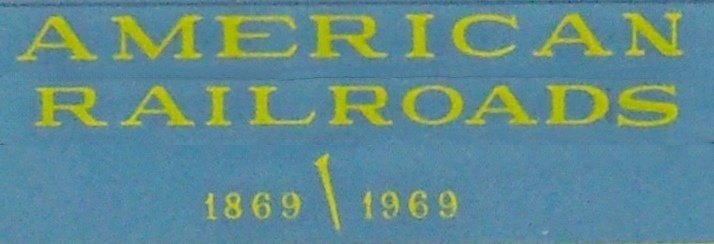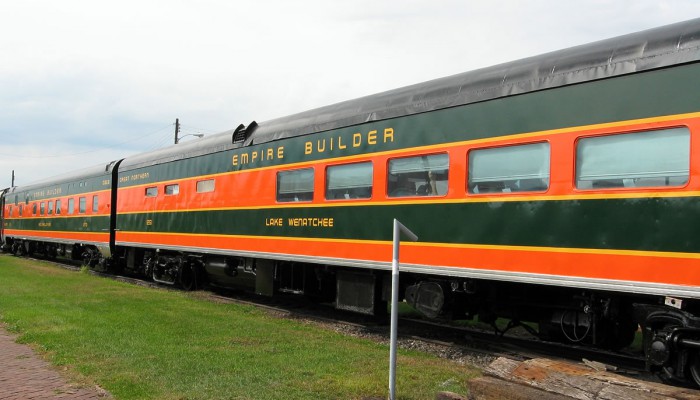Model Information: The Atlas/Rivarossi smoothside baggage RPO prototype: It has always been rumored/assumed that the car was a modeled after a PRR heavyweight modernized to appear lightweight, probably because the other two lightweight cars were PRR. The actual key was the builder, ACF. I finally found a photo of the very car in "Trains We Remember" by Robert J, Wayner. This is a model of a Baggage, 30' Mail Car, based on a pair of ACF Army Hospital cars converted by the Monon. The cars were part of ACF lot number 2733, ordered 5/1944 and delivered 12/1944. These cars had wider than normal vestibule doors to facilitate stretchers. [Stretchers were also passed through opening windows and mid-car doors.] The Monon purchased 28 cars in 1947 (their entire lightweight fleet) and converted two to this configuration. The car, having what appears to be a vestibule on one end, looks fictitious. This is actually correct for the Monon cars. The under carriage detail is the same as that for Rivarossi's observation car and is thus totally wrong. The real cars were equipped with three axle passenger trucks even though they were considered lightweight (presumably to provide a smoother ride for wounded soldiers).
Prototype History: In the post-war period, passenger rail service boomed. In order to increase efficiency, the railroads set to replacing their old wood, steel and concrete heavyweight passenger cars with newer lightweight, streamlined cars. The new cars were made from stainless steel, aluminum and Cor-Ten steel. These cars required less motive power to pull and were cheaper to manufacture. Production was also concentrated in a few manufacturers rather than each railroad making its own. This led to standardization which further reduced costs. The new "lightweight" cars were also given "streamlined" designs to make them more visually appealing. Budd, Pullman Standard and ACF were all well known manufacturers of these cars.
Smoothside cars are typically painted, unlike their corrugated brethren. This meant that they typically required more maintenance, but this also allowed the railroads to apply distinctive paint schemes to their fleets, typically matching the paintwork on their locomotives.
Smoothside cars are typically painted, unlike their corrugated brethren. This meant that they typically required more maintenance, but this also allowed the railroads to apply distinctive paint schemes to their fleets, typically matching the paintwork on their locomotives.
Road Name History:  In the springtime of 1969, the High Iron Company (a travel agency specialised in rail journeys for railway enthusiasts) offered a special rail journey from New York to Promontory Point in Utah, for commemorating the centenary of the joining of the two railroads., thus travelling across all the US territory, linking the west coast federation with the east coast, One hundred years previously at Promontory Point, the event has been celebrated, by hammering a golden nail, to symbolically link the two railroads. A hundred years on… a similar ceremony was to be organised, thus a special train , named the “Golden Spike”. The train leaving from NY for Kansas City hauled by a Steam train 2-8-4 n. 759 re painted for the occasion in black and blue, with the logo “American Railroads” in gold.
In the springtime of 1969, the High Iron Company (a travel agency specialised in rail journeys for railway enthusiasts) offered a special rail journey from New York to Promontory Point in Utah, for commemorating the centenary of the joining of the two railroads., thus travelling across all the US territory, linking the west coast federation with the east coast, One hundred years previously at Promontory Point, the event has been celebrated, by hammering a golden nail, to symbolically link the two railroads. A hundred years on… a similar ceremony was to be organised, thus a special train , named the “Golden Spike”. The train leaving from NY for Kansas City hauled by a Steam train 2-8-4 n. 759 re painted for the occasion in black and blue, with the logo “American Railroads” in gold.
The return journey the steam locomotive handed over the task to the modern GG1 n. 4092 which the Penn Central repainted for the occasion , using the design of the artist Robert Lorenz of Fremont in Ohio.
After its initial debut with the « Centennial Special", this G.G.1 n.4902 continued normal duties on the New York-Washington line.
From Rivarossi Memory.

The return journey the steam locomotive handed over the task to the modern GG1 n. 4092 which the Penn Central repainted for the occasion , using the design of the artist Robert Lorenz of Fremont in Ohio.
After its initial debut with the « Centennial Special", this G.G.1 n.4902 continued normal duties on the New York-Washington line.
From Rivarossi Memory.
Brand/Importer Information:  Founded in 1906 by Karl Arnold in Nuernberg, K. Arnold & Co. began its life producing tin toys and related items. They produced an extensive line of model ships, doll house items and other toys. In 1935, K. Arnold & Co. hired Max Ernst as their managing director. Ernst, not to be confused with the German realist artist of the same name, was a significant factor in the future of Arnold.
Founded in 1906 by Karl Arnold in Nuernberg, K. Arnold & Co. began its life producing tin toys and related items. They produced an extensive line of model ships, doll house items and other toys. In 1935, K. Arnold & Co. hired Max Ernst as their managing director. Ernst, not to be confused with the German realist artist of the same name, was a significant factor in the future of Arnold.
There are several distinct phases of Arnold's model train production. In the period of 1960 - 1962, Arnold marketed the Arnold Rapido 200 product line; this line was very crude yet it also was a sensation because of its much smaller size than TT.
The next phase was from 1963-1967, when the rapido product line begins to swing toward scale representations of the trains. It is during this period that the "Rapido Coupler" comes into production, beginning its widespread use by all model train manufacturers in N-Scale. It was in 1964 that the term "N-Scale" came into use. Between 1968 and 1970, rapido line of trains reached maturity, notably with its turntable and roundhouse. Arnold entered into a business relationship with the U.S. company Revell around 1968, beginning the marketing of Revell Rapido model trains. This relationship was marked by the beginning of production of more accurate North American prototype models by Arnold. This relationship continued for several years, ending in the late 1960s or early 1970s. Arnold continued their expanded production, with new models until the early 1990s.
On Max Ernst's 1976 retirement, Arnold employed perhaps 200 to 250 people, using three facilities in the Nurnberg area. The Company continued under family control until 1995, when Arnold went into bankruptcy and was sold to Rivarossi of Italy. Rivarossi, in turn, also went bankrupt, leading to the sale of all assets to Hornby of the United Kingdom. Production is carried out in China.

There are several distinct phases of Arnold's model train production. In the period of 1960 - 1962, Arnold marketed the Arnold Rapido 200 product line; this line was very crude yet it also was a sensation because of its much smaller size than TT.
The next phase was from 1963-1967, when the rapido product line begins to swing toward scale representations of the trains. It is during this period that the "Rapido Coupler" comes into production, beginning its widespread use by all model train manufacturers in N-Scale. It was in 1964 that the term "N-Scale" came into use. Between 1968 and 1970, rapido line of trains reached maturity, notably with its turntable and roundhouse. Arnold entered into a business relationship with the U.S. company Revell around 1968, beginning the marketing of Revell Rapido model trains. This relationship was marked by the beginning of production of more accurate North American prototype models by Arnold. This relationship continued for several years, ending in the late 1960s or early 1970s. Arnold continued their expanded production, with new models until the early 1990s.
On Max Ernst's 1976 retirement, Arnold employed perhaps 200 to 250 people, using three facilities in the Nurnberg area. The Company continued under family control until 1995, when Arnold went into bankruptcy and was sold to Rivarossi of Italy. Rivarossi, in turn, also went bankrupt, leading to the sale of all assets to Hornby of the United Kingdom. Production is carried out in China.
Item created by: Alain LM on 2020-06-13 05:53:51. Last edited by Alain LM on 2020-06-13 12:27:42
If you see errors or missing data in this entry, please feel free to log in and edit it. Anyone with a Gmail account can log in instantly.
If you see errors or missing data in this entry, please feel free to log in and edit it. Anyone with a Gmail account can log in instantly.










